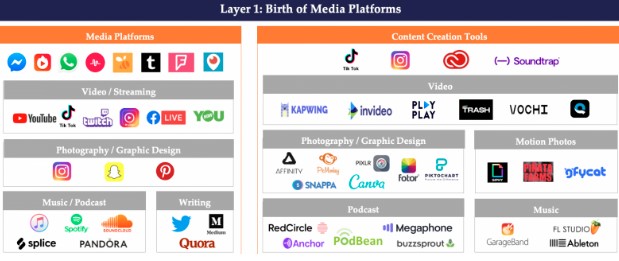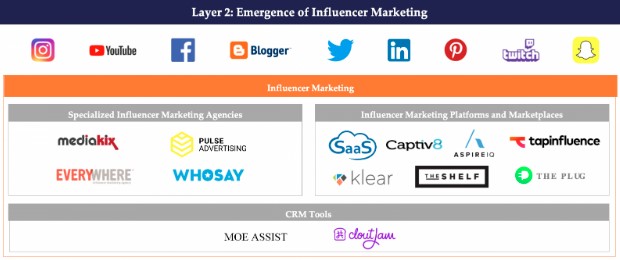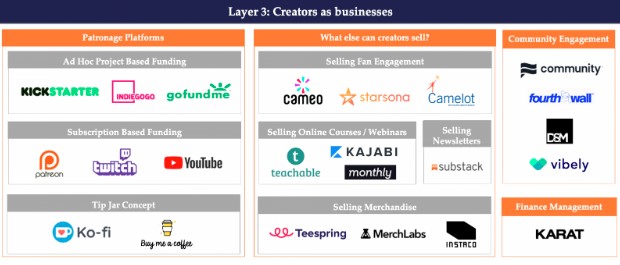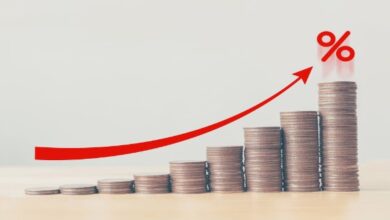Creator Economy: Ins and Outs

A different class of business that works with the advancement of technology. There are more than 50 million independent content creators, curators, and community builders including social media influencers, bloggers, and videographers are a part of the creator economy.
What is the Creator Economy?
According to Eric Freytag of Streamlabs, in a VentureBeat article he wrote, “Instead of 10 TV shows being watched by billions of people, there are now hundreds of millions of shows available to cater to billions of people.
You could be one out of ten people who are passionate about a niche topic, but chances are you can find content on it. Additionally, the people who make it are engaging in it honestly and authentically.”
Top 3 Trends: Creator Economy
- As creators move their top fans away from social networks and onto their own websites, apps, and monetization tools, they are moving away from social networks.
- Artists who want to start businesses, form teams, and assemble tools in order to do so while concentrating on their art.
- Fans are becoming more passionate about connecting with creators as they seek individual personalities over faceless publishers.
In spite of the fact that the creator economy only emerged a decade ago, more than 50 million people around the world consider themselves creators.
According to a survey, a YouTube star is the fastest-growing type of small business, and more American kids want to be an astronaut (11%) than YouTube stars (29%) when they grow up.
How Many Creators Are There?
There are two types of creators in the business right now, Profession Individual Creators and Amateur Individual Creators. Professionals are making content full-time, whereas; Amateur monetizing content is their part-time duty.
Full-time: Professional Individual Creators (~2M+)
- From 31M channels on YouTube, 10K subscriptions have for ~1M creators (source)
- In Instagram, from 1 billion accounts 500K have followers over 100K who are considered active influencers. (Source)
- Twitch: Approximately, 3M streamers exist here and ~300K have Affiliate status or Partner.
- Others: A total of ~200K have other creators. Such as musicians, podcasters, writers, illustrators, etc
Monetizing Part-time: Amateur Individual Creators (~46.7M)
- YouTube: Out of the 31M channels on YouTube, ~12M have between 100-10K subscribers (source)
- In Instagram, from 1 billion accounts ~30M have followers between 50-100K (Source)
- Twitch: Approximately, 3M streamers exist here and ~2.7M are Affiliates or non Partner.
- Others: Might be a total of ~2M have other creators. Such as musicians, podcasters, writers, illustrators, etc
Creator Economy: A Brief History
In order to understand what tools are available, we need to take a step back and understand how the creator economy has evolved, which is divided into 3 overlapping layers.
Layer 1: Foundational Media Platforms
YouTube, Instagram, iTunes, Spotify, as well as Twitter, Twitch, TikTok, Medium, and others have dominated the internet market for the last decade. come into existence.
In addition to investing heavily in recommendation algorithms, platforms help creators establish audiences by recommending and curating content.

Suddenly, creators no longer had to create content and choose an audience based on large production companies. The rise of multichannel networks like Maker and Fullscreen is attributable to these platforms.
As a result of these platforms, multimedia editing tools were also created to help creators polish their content.
Content creators should, however, be aware that platforms do not always have their best interests at heart, which is why smart creators cross-promote and diversify across multiple apps to minimize their “platform risk”.
Layer 2: Monetizing Influencer Reach
Following the emergence of top creators with an established audience that trusted what they shared, brands began to recognize the value in paying creators to leverage their reach on social channels to promote products and services.
The growth of sponsored content and companies like Niche that broker these deals led to the growth of some platforms splitting traditional ad revenue with creators while others left it up to the content makers to decide how to monetize.

Influencer marketing is a booming business, with over 100 companies operating in the space, including influencer agencies, sponsorship marketplaces, and talent representation agencies.
In terms of TAM, Mediakix reports that influencer marketing is currently worth $8bn, and it’s expected to grow to $15bn by 2022. Ideally, sponsors should align with creators’ branding and not compromise content quality to push corporate messaging.
Nevertheless, as influencer marketing became more common and more brands began to pay for it, influencers noticed a pattern: with each paid post, they lost some of the trust that they built with their audience, resulting in less engagement and growth.
Thus we come to the most recent wave of creators’ evolution.
Layer 3: Creators as Businesses
Here we are! Fans can convert into a full-fledged business with multiple revenue streams beyond ads after developing fandoms that follow them off-platform.
As creators look for ways to earn money, companies are stepping up to support them by providing products like premium content, merchandise, books/ebooks, newsletters, or services like fan engagement, coaching, consulting, and speaking engagements.

Rather than desperately trying to reach the biggest audience and making clickbait content, creators can focus on making more unique niche content that delights their biggest fans.
It is crucial that creators balance the potential of certain platforms with their capacity to become dependent on them in order to earn money and either monetize a little on those platforms or earn money from other means, mainstream content through the connections made to a large audience or by monetizing a lot from niche content to a smaller audience.
It’s getting increasingly difficult for creators to make a living solely from their creations, and they’re being funded directly by their fans over time.
Since platforms like YouTube have shifted the economy away from creators generating revenue through ad revenue shares in exchange for bringing in an audience to the platforms, brands are paying creators for their reach through platforms like Instagram and Snapchat, and fans are paying creators via patronage and tips as well as E-commerce in exchange for entertainment and community beyond the platforms.
Creators: The New Founders
Without any doubt, becoming a professional creator is considered one of the most desired jobs in this era. Love to create something innovative that makes creators become a creator.
However, creators are constantly growing their audience and expanding revenue channels which results in the burden of maintaining day-to-day of their business growth.
Entrepreneurs who are focused on empowering content creators to seamlessly monetize while remaining focused on what they already love – creating content – will dominate the next stage of this evolution.
To be a creator today means moving beyond being an artist and becoming a founder. The position encompasses a variety of roles including product management, design, community engagement, e-commerce, data science, and entertainment.
However, diversification also brings resilience. By having a direct relationship with their fans, creators are less prone to the shifting priorities of big tech companies. There is no limit to the number of revenue streams a creator can build to fit his or her style.
Creating esoteric content that caters to our specific interests is a big win for everyone because those creators can build a successful careers.
We get an array of content suited to every sub-culture under the sun, instead of just homogenous, lowest common denominator primetime sitcoms.
Finally, there are enough creators to sustain an ecosystem of startups supporting them as they turn their passions into careers.

